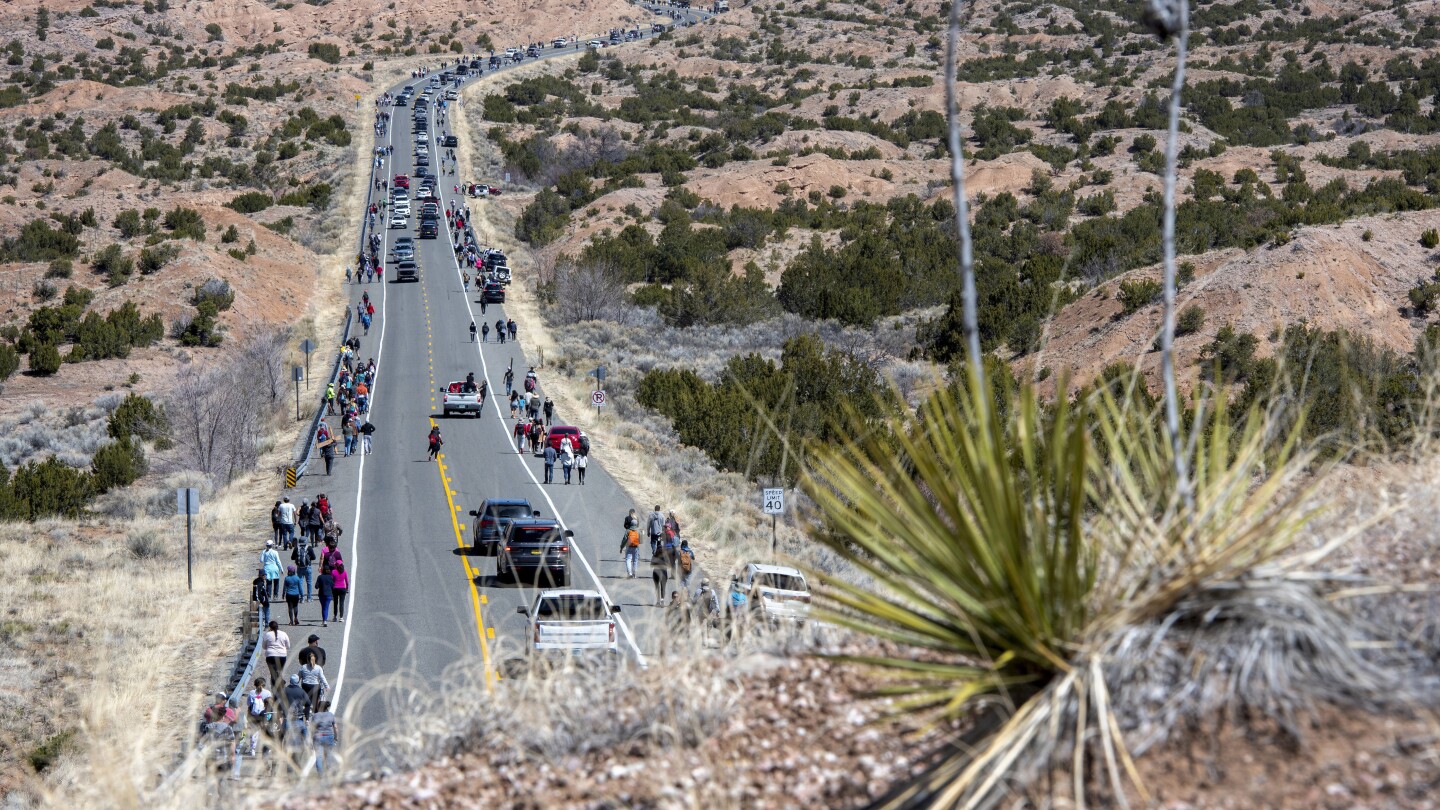Lifestyle
This federal rule helped clear air over America’s most beloved parks. Trump’s EPA wants to kill it

During a hike in the Great Smoky Mountains National Park in 1995, Don Barger climbed Chilhowee Mountain hoping to gaze across the valley below. All he saw was a wall of gray haze.
Today, he said, he can see some 50 miles (80 kilometers) across that same valley to the Cumberland Mountains.
A 26-year-old federal regulation known as the regional haze rule has helped cut down on pollution over national parks, wilderness areas and tribal reservations, restoring some of the nation’s most spectacular natural vistas for outdoor lovers like Barger. But conservationists fear those gains may be lost after President Donald Trump’s administration announced in March the rule is among dozens of landmark environmental regulations that it plans to roll back.
“It means a promise that was made to the American public is lost,” Barger, 74, said. “More and more generations of people are going to grow up as ignorant as I was, not realizing what I’m missing and not seeing.”
Congress pushes to clean air over parks, wilderness areas
Haze forms when small particles of air pollution, such as sulfur dioxide or nitrogen oxides, scatter and absorb sunlight, blurring views and decreasing visibility.
Congress amended the Clean Air Act in 1977 to make restoring and maintaining visibility a goal for 156 national parks, wilderness areas, wildlife refuges and tribal reservations across 36 states. That includes places like the Great Smoky Mountains National Park in North Carolina and Tennessee; Grand Canyon National Park; Glacier National Park; and the Boundary Waters Canoe Area Wilderness.
After years of drafting and litigation, the U.S. Environmental Protection Agency adopted regulations known as the regional haze rule in 1999 to implement the amendments.
The rule calls for attaining natural visibility conditions by the year 2064 and mandates that states come up with plans that include limitations on emissions, compliance schedules and monitoring strategies. Older facilities that emit pollution, such as coal-fired power plants, must adopt mitigation technology such as scrubbers or shut down periodically to decrease overall annual emissions.
A work in progress
The states’ plans have been plagued with delays as the EPA approves parts of them and rejects others. For example, two big oil- and coal-producing states, North Dakota and Wyoming, and industry groups filed petitions in federal court in January seeking review of EPA decisions rejecting their plans, according to the Harvard Law School’s Environmental and Energy Law Program.
The rule works in conjunction with other federal antipollution regulations, but it’s been crucial in clearing the skies over national parks and wilderness areas.
An Associated Press analysis of data from a nationwide network of monitoring sites from 1999, when the rule was implemented, through 2023 shows 93% of the parks and wilderness areas have seen improved air quality on clear days. No parks or wilderness areas have seen any notable worsening in visibility.
Visibility in the Great Smoky Mountains National Park was twice as good on a typical clear day in 2023 as it was in 1999, marking the biggest improvement among the national parks.
The EPA estimates that between 2007 and 2018 the rule has cut 500,000 tons of sulfur dioxide and 300,000 tons of nitrous oxides annually. The average visual range has increased from 90 miles to 120 miles (144 kilometers to 193 kilometers) in some western parks and from 50 to 70 miles (80 kilometers to 112 kilometers) in some eastern parks, according to the Harvard program.
‘Most consequential day of deregulation’
Trump’s EPA administrator, Lee Zeldin, announced March 12 that the agency would look to roll back 31 landmark environmental regulations, including the regional haze rule. Zeldin called the announcement the “most consequential day of deregulation in American history” and said in an essay published in the Wall Street Journal that the administration is “driving a dagger through the heart of climate-change religion.”
Asked for comment on the regional haze rule, the EPA said they want to better account for pollution from outside the U.S. and from natural sources and avoid unnecessary burdens for states and industry.
Has the rule hurt energy producers?
In a cost-benefit analysis of the rule before it took effect, the EPA found it would cost energy producers up to $98 billion by 2025 while providing about $344 billion in benefits such as health care savings.
Producers argue that the haze rule has done its job and it doesn’t make sense to continue to impose costs on them.
“This is a matter of diminishing returns,” said Jonathan Fortner, interim president and CEO of the Lignite Energy Council, which advocates for North Dakota’s coal industry. “The air is clean, the data proves it, and the science backs that up. The rule’s being misapplied, not because we disagree with clean air goals, but because we’re already there.”
Two federal properties in North Dakota are subject to the rule, the Lostwood National Wildlife Refuge and Theodore Roosevelt National Park. The AP analysis found both sites have seen dramatic visibility improvements over the five years from 2019 to 2023.
EPA officials did not respond to an AP request for a list of power plants that have closed due to the regional haze rule. A number of energy industry groups did not return repeated requests for comment, including the U.S. Energy Association and the National Utility Contractors Association.
What’s next for the parks?
Advocates of the rule say eliminating it could lead to reduced tourism and the economic boom visitors bring to national park regions. The National Park Service estimates 325 million people visited national parks in 2023, spending $26.4 billion in gateway communities.
Nothing appears likely to change overnight. Conservationists expect the Trump administration to pursue a rollback through language revisions in the rule, a process that would require a public comment period and would likely trigger court challenges that could last years.
“I’ve watched the Great Smoky Mountains National Park emerge from the chemical haze that once enshrouded it and was getting worse,” Barger said. “It’s just this visceral sense of place. We had lost it entirely. The Clean Air Act is working and it’s a work in progress. You have to stay with it or it doesn’t work.”
___
Associated Press Science Writer Seth Borenstein contributed to this report.
___
The Associated Press’ climate and environmental coverage receives financial support from multiple private foundations. AP is solely responsible for all content. Find AP’s standards for working with philanthropies, a list of supporters and funded coverage areas at AP.org.
Lifestyle
Look inside Maine’s ‘Sistine Chapel’ with 70-year-old frescoes

SOLON, Maine (AP) — From the outside, it looks like any other New England church building: a boxy, white structure with a single steeple surrounded by an old stone wall, set against rolling hills and pine forest.
Inside, though, the South Solon Meeting House has a secret unknown even to some who drive through the tiny Maine town every day. The interior of the building is covered in 70-year-old fresco murals that encourage some in the state’s art community to describe it as “Maine’s Sistine Chapel.”
The murals were painted by artists in the 1950s and, while they have long been appreciated by visitors, the recent creation of a website dedicated to them by students at Colby College in Waterville, Maine, has generated new interest in the paintings.
Véronique Plesch, a Colby professor of art, hopes the building inspires more appreciation of frescoes.
“I fell in love with the place, because I have studies frescoes all my life,” said Plesch, who is a member of the board of the historical society that cares for the meeting house. She added that the paintings should stay in public places and not be in private institutions.
The meeting house was built in 1842 and hosted church services until the 1940s, though there were periods of closure, such as times of war. A decade later, Margaret Day Blake found the building in a state of disuse and the former student at the nearby Skowhegan School of Painting and Sculpture put out a call for young artists to paint frescoes under the school’s supervision in 1951.
The artists were given creative freedom and told there would be no limits to subject matter, but that Biblical scenes would “offer rich and suitable” imagery. The interior was covered in such scenes from 1952 to 1956 and the walls remain adorned with frescoes, including one that references Leonardo da Vinci’s “The Last Supper.”
Another fresco depicts the binding of Isaac, in which a hooded Abraham prepares to sacrifice his son on God’s orders. The Great Flood is depicted as it was by Michelangelo at the Sistine Chapel at the Vatican.
Two of the 13 artists — Sigmund Abeles of New York City and Sidney Hurwitz of Newton, Massachusetts — both in their 90s, are still living. Both spoke fondly about their time at the meeting house.
“We would go out there and paint and then take a lunch break in the cemetery behind the building. It was a very idyllic time,” Hurwitz said. “I very much enjoyed it.”
Today, the meeting house, which is open to the public without locks on its doors, serves as a community gathering and performance space. Many of its old features, including box pews made for smaller people of a different time, are still intact.
Abeles recalled painting the scene of Jacob wrestling with the angel from the Book of Genesis.
“It’s a very, very special place, and it was a unique experience” to work on the frescoes, Abeles said.
On a recent Sunday morning, Plesch gave a lecture at the meeting house before a group of members of the Maine Art Education Association as part of the group’s spring conference. Long ago, attendants of the building might have been preparing for an Easter service, but on this day it was full of teachers fascinated by the frescoes.
Suzanne Goulet, an art teacher at a nearby high school, said she was previously aware of the frescoes and confessed she had peaked into the windows of the old building, adding that it’s great the paintings are still inspiring art lovers decades later.
“The inspiration is that we bring it back to our students,” Goulet said.
Lifestyle
Thousands of pilgrims trek through New Mexico desert to historic adobe church for Good Friday

SANTA FE, N.M. (AP) — A unique Holy Week tradition is drawing thousands of Catholic pilgrims to a small adobe church in the hills of northern New Mexico, in a journey on foot through desert badlands to reach a spiritual wellspring.
For generations, people of the Upper Rio Grande Valley and beyond have walked to reach El Santuario de Chimayó to commemorate Good Friday.
Pilgrims, some walking for days, were on track to arrive Friday amid a forecast of cool temperatures and sprinkles of rain.
Some travelers are lured by an indoor well of dirt believed to have curative powers. Throughout the year, they leave behind crutches, braces and canes in acts of prayer for infirm children and others, and as evidence that miracles happen.
Easter week visitors file through an adobe archway and narrow indoor passages to find a crucified Nuestro Señor de Esquipulas at the main altar. According to local lore, the crucifix was found on the site in the early 1800s, a continent away from its analog at a basilica in the Guatemalan town of Esquipulas.
A spiritual place
Chimayó, known for its artisan weavings and chile crops, rests high above the Rio Grande Valley and opposite the national defense laboratory at Los Alamos that sprang up in the race to develop the first atomic weapon.
The iconic adobe church at Chimayó was cast from local mud at the sunset of Spanish rule in the Americas in the early 1800s, on a site already held sacred by Native Americans.
Set amid narrow streets, curio shops and brooks that flow quickly in spring, El Santuario de Chimayó has been designated as a National Historic Landmark that includes examples of 19th century Hispanic folk art, religious frescoes and saints carved from wood known as bultos.
One votive room is filled with notes of thanks from those who say they had ailments cured.
A separate chapel is dedicated to the Santo Niño de Atocha, a patron saint of children, travelers and those seeking liberation and a fitting figure of devotion for Chimayó pilgrims on the go.
Hundreds of children’s shoes have been left in a prayer room there by the faithful in tribute to the holy child who wears out footwear on miraculous errands. There are even tiny boots tacked to the ceiling.
Pueblo people who inhabited the Chimayó area long before Spanish settlers believed healing spirits could be found in the form of hot springs. Those springs ultimately dried up, leaving behind earth attributed with healing powers.
A way of life
Photographer Miguel Gandert grew up in the Española valley below Chimayó and made the pilgrimage as a boy with his parents.
“Everybody went to Chimayó. You didn’t have to be Catholic,” said Gandert, who was among those who photographed the 1996 pilgrimage through a federal grant. “People just went there because it was a powerful, spiritual place.”
Scenes from that pilgrimage — on display at the New Mexico History Museum in Santa Fe — include children eating snow cones to keep cool, men shouldering large wooden crosses, infants swaddled in blankets, bikers in leather and weary pedestrians resting on highway guardrails to smoke.
A generation later, Good Friday pilgrims still haul crosses on the road to Chimayó, as families leave behind cars, push strollers and allow time for older hikers. Throngs of visitors often wait hours for a turn to file into the Santuario de Chimayó to commemorate the crucifixion.
It’s just one of hundreds of adobe churches anchoring a uniquely New Mexican way of life for their communities. Many are at risk of crumbling into the ground in disrepair as congregations and traditions fade.
A journey on foot
Pilgrims from nearby towns set out for Chimayó in the predawn hours. Some have walked 20 miles (32 kilometers) from Santa Fe, while others traveled for days from Albuquerque and elsewhere.
Vendors sell religious trinkets, coffee and treats. State transportation workers, law enforcement agencies and other volunteers are stationed along the roadway to ensure safety from oncoming traffic, the outdoor elements and exhaustion.
Pilgrims traverse an arid landscape speckled with juniper and piñon trees and cholla cactus that finally give way to lush cottonwood trees and green pastures on the final descent into Chimayó.
The magnitude of the religious pilgrimage has few if any rivals in the U.S. Many participants say their thoughts dwell not only on Jesus Christ but on the suffering of family, friends and neighbors with prayers for relief.
___
Associated Press religion coverage receives support through the AP’s collaboration with The Conversation US, with funding from Lilly Endowment Inc. The AP is solely responsible for this content.
Lifestyle
Ralph Lauren stays closer to home this time with intimate Manhattan gallery show

NEW YORK (AP) — Ralph Lauren, known for staging elaborate runway shows in sumptuous settings like the horsey Hamptons or amid his vintage car collection, took it down a notch for a more intimate show Thursday in a Manhattan gallery space.
As celebrities like Anne Hathaway, Michelle Williams, Julia Louis-Dreyfus, Ariana DeBose and many others watched from the front row, Lauren presented a fall collection dubbed “The Modern Romantics,” heavy on high ruffled necks, classics like buttery leather in everything from aviator jackets to bustiers, and soft cashmere. Evening looks were long and lacy.
Models descended a grand staircase in an airy gallery setting
Lauren’s models first appeared atop a balcony, then each descended a grand staircase to walk the runway. The venue, now the Jack Shainman Gallery, was built in 1898 in the Italian Renaissance Revival style.
For the New York-based crowd, it was much less of a journey than Lauren’s last show in the Hamptons on Long Island, which took some guests four hours from Manhattan in busy traffic.
Lauren himself appeared at the end of the show to wave — from the top of the balcony.
A romantic theme
Lauren said he was celebrating “The Modern Romantics,” an aesthetic he described as “self-assured and unbound by rules.”
Strutting the runway, the models displayed looks that began with a classic Lauren combination of black trousers, a high-necked ruffled white shirt, and an aviator jacket in brown distressed leather.
That was followed by a filmy white midi-dress paired with a thick black leather belt, and tall black leather boots.
A black leather bustier was paired with a long camel wool skirt, and white lacy ruffled shirts popped up in different ensembles — with a long camel coat, or a puffy brown cardigan. There were also white lace neckties. There were velvet jackets, including in a deep shade of purple.
Outfits segued into evening with long, silky or strappy gowns, one in a white crochet theme, another in sumptuous black lace. There was a black halter gown in tiers of ruffles spiraling around the body.
Celebs in attendance
Hathaway, Williams and Watts sat together in the front row, each in a Lauren-style trench or wrap coat. Hathaway, her hair pulled back in a tight ponytail, paired her coat with a pair of tan-colored jeans, embroidered with sequins and strategically shredded.
DeBose wore a smart gray suit that would go perfectly with next month’s Met Gala dress code: “Tailored For You.” Louis-Dreyfus wore a cropped leather jacket in light brown, with white trousers.
Also attending were Sadie Sink, Sarah Catherine Hook, Eiza Gonzalez, Andra Day, Kacey Musgraves and Ella Hunt, among others.
Seen and heard at Lauren’s show
“I thought it was very much his sensibility and what he believes,” Anna Wintour, the influential Vogue editor, said after the show, noting that Lauren’s fashion transcended trends. “He’s a designer that never looks to the left or to the right. He’s just very clear in what he wants to say and what his customer wants, and that’s one of the reasons he’s so unbelievably successful.”
Sarah Catherine Hook, who appeared in the recently concluded third season of “The White Lotus,” said she liked the collection’s ephemeral feel.
“I love anything timeless and I feel like this is the most timeless you could possibly get,” Hook said. “I love the masculine-feminine mix of it and this is my first time getting to wear a necktie, so I’m feeling pretty chic today.”
-

 Europe2 days ago
Europe2 days agoCody Balmer, the suspect in arson at Pennsylvania governor’s home targeted the governor for his views on war in Gaza, warrant says
-

 Education2 days ago
Education2 days agoTrump administration revokes humanitarian parole of Spanish teacher
-

 Conflict Zones2 days ago
Conflict Zones2 days agoAfter two years of war in Sudan, the world can no longer plead ignorance | Conflict
-

 Conflict Zones17 hours ago
Conflict Zones17 hours agoHaiti in ‘free fall’ as violence escalates, rights group warns | Armed Groups News
-

 Sports2 days ago
Sports2 days agoStephen Curry and Jimmy Butler lift the Warriors past the Grizzlies and into the NBA Playoffs
-

 Sports2 days ago
Sports2 days agoNew Orleans Saints win lawsuit over fleur-de-lis trademark filed by ‘direct descendant of the Kings of France’
-

 Africa2 days ago
Africa2 days agoWorld Trade Organization says global trade could slide this year due to tariffs
-

 Africa2 days ago
Africa2 days agoSudan: Rapid Support Forces leader announces rival government




